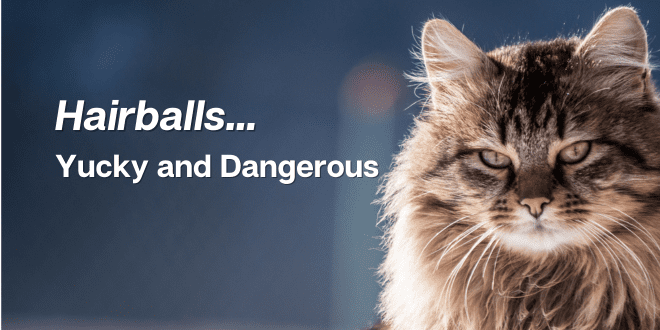
Hairballs are the yucky, tubular evidence that your cat has been grooming. When you first see a hairball on the carpet or floor, you may easily mistake it for feces because of its color and shape. Based on the lack of fecal odor, your nose will quickly tell you though that this yucky thing came out of the other end of the cat.
What is a Hairball?
Cats as famously fastidious groomers and because of the backward-facing barbs on the tongue, the hair that gets trapped by these barbs will be sent down the throat and and either vomited back up, or continue to travel toward the stomach. A small amount of loose hair that goes through the digestive system will often just pass through without problem and end up mixed in with the feces. Upon closer inspection of your cat’s fecal deposit, you may notice some hair wrapped in there.
Sometimes the amount of hair swallowed is so dense that it can’t pass through the stomach and gets regurgitated back up in the form of that tubular shaped hairball.
What Causes Hairballs?
Hairballs are caused by grooming but the cause of the grooming can vary. It can be that some cats are more prone to them just from normal grooming but they can also be the result of things such as over-grooming. A stressed cat that engages in over-grooming to self-soothe may be more likely to experience more frequent hairballs. A cat may groom particular parts of the body over and over again due to pain (such as arthritis) and the increased amount of ingested hair may result in hairballs. If your cat has a flea allergy, you may notice increased grooming. It’s important to pay attention to changes in your cat’s grooming. If you notice your cat is grooming more than normal, it’s time for a check-up from the veterinarian to rule out any underlying medical cause. Behavioral issues may also need to be talked about with your veterinarian if stress-related grooming is suspected. If stress is suspected, your veterinarian may refer you to a certified behavior expert such as a veterinary behaviorist.
Longhaired Cats and Shorthaired Cats
Typically, longhaired cats are more prone to hairballs but it also depends on how much a particular cat grooms. Keep in mind how much cats may groom each other so in a multicat household, a shorthaired cat may end up with a hairball problem just because of how much they may groom their longhaired feline companion.
The Danger of Hairballs
There are also times when the hairball passes out of the stomach but gets stuck in the intestinal tract and that can become a life-threatening situation because it can cause an obstruction. If this happens, surgery is usually necessary to remove the blockage. If surgery isn’t indicated, your cat will still have a long hospital stay that includes hydration therapy, laxatives ,and close monitoring. Either situation will be stressful on the cat, uncomfortable, and potentially life-threatening.
Some signs of a hairball problem or possible impaction can include:
- Vomiting of undigested food
- Inability to pass stool. You may notice the cat in the litter box in a perched position.
- Repeated dry heaving
- Abdominal swelling
- Loss of appetite
- Increased vocalization
Preventing Hairballs
Brush Your Cat
Reduce the amount of hair ingested through self-grooming by making sure you regularly brush your cat. The more hair you can trap in a brush means less hair your cat ends up swallowing. If your cat doesn’t enjoy being brushed but has a tendency toward hairballs, work on creating a more positive, casual, and quick grooming process. Start with a grooming glove so it’s initially just an extension of petting. Work up to doing just a couple of strokes with a brush and then offer a yummy treat. You can also try distracting your cat by offering some Churu on a Lickimat. These products are available at your local pet product store and online. If you have a helper, that person can distract your cat with the Churu treat while you do the brushing. Don’t make the grooming session a long, torturous session, but instead, do a little every day so it’s over before your cat has time to complain.
Dietary Help
There are hairball control foods available that may help any swallowed hair pass through the gastrointestinal tract more easily. You can also talk to your veterinarian about increasing fiber in the diet. Don’t make any dietary changes though without first consulting with your veterinarian because an inappropriate change in the amount of fiber can have extremely uncomfortable side effects. Your veterinarian may also place your cat on nutritional supplements to help bolster the diet and help prevent hairballs. The key to managing hairballs is to be consistent if the veterinarian does recommend a prescription food or nutritional supplements.
Hairball Prevention Products
There are oral products that come in a paste or gel form that are designed to help ease the passage of hairballs through the intestines by coating the hairball and the stool. They are flavored in a way that most cats enjoy so your kitty may easily just lick the product from your finger. If not, you can put a little of the product on the roof of the mouth. Hairball prevention products are usually administered once or twice a week. If you have questions about how much to use or how often to administer, consult your veterinarian. There are also hairball prevention treats for cats.
Water
Make sure your cat is drinking enough water. Keep the water bowl filled with fresh, clean water. If you’re concerned that your cat isn’t drinking enough, consider getting a pet water fountain. Often, the running water from the pet fountain entices cats to drink more. Wash the bowl daily and refill with fresh water to prevent the buildup of biofilm.
Need More Information?
If your cat has an ongoing hairball problem or if methods you’ve tried aren’t working, be sure to consult with your veterinarian. A hairball blockage can be life-threatening so you don’t want to waste time playing wait-and-see when it comes to your cat’s health.
For information on cat behavior and training, refer to the books by Pam Johnson-Bennett. Pam’s books are available at bookstores and online. We’ve included links to Amazon here on our website.
If you have a question regarding your cat’s health, please contact your veterinarian. This article is not intended as a replacement for your cat’s veterinary care.

